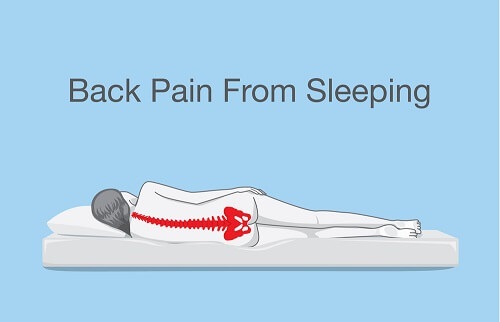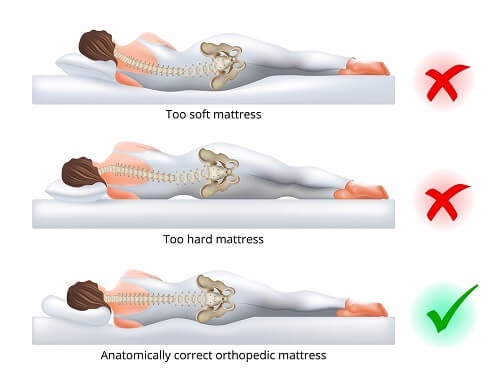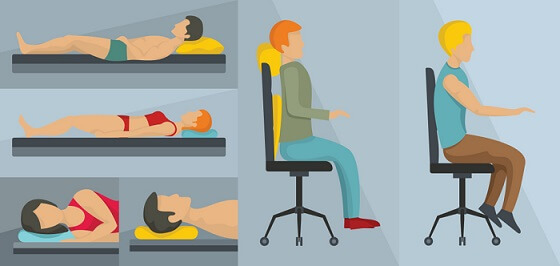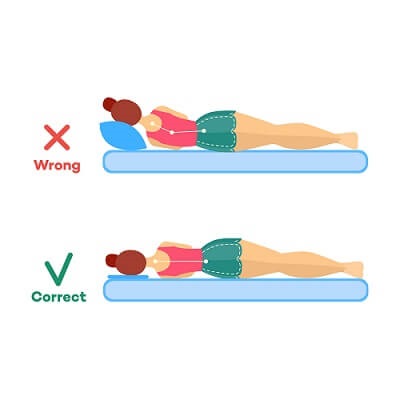Mattresses have a crucial role in good sleep as well as in achieving good health. The right mattresses provide you a great night’s sleep by giving both the right support and right comfort level. It is often mistaken with the quantity of sleep with quality.
According to research and studies, adults need sleep of at least 7 to 8 hours each night. However, not getting enough sleep due to back pain is a common problem found among them which can have serious impacts on their health and well-being.
If your mattresses do not support your spine in the right manner, no use if you had a long night’s sleep as it will not make you feel good in particular! In addition, it may cause back pain. Yes the most common case of sleeping in a bad mattress is back pain.
There could be several other factors that can affect back pain, but a good mattress makes a positive difference like it relaxes muscles, improves sleeping posture and overall provides a wholesome sleep. In the same way, a wrong mattress can worsen your condition by increasing the pain. But keep in mind, there is no “perfect” mattress for everyone. Thus choosing a mattress that suits your natural sleeping posture is very important.
There are so many mattresses out there with different features and comfort levels. It is imperative that you need to research and learn about some of it before investing in something that is important for your overall well-being.
So, don’t you feel mattresses matter? You will feel it at least when you are waking up with back pain in the morning. This guide provides you all the information regarding back pain, its causes and how it is influenced by your sleep on different mattresses. The guide will help you to choose the perfect mattress for your health.
Facts and Statistics of Back Pain

In fact, more or less 31 million people in America experience back pain at any time.
Interesting Facts Concerning Back Pain-
- Back pain is regarded as the single leading disability that causes the prevention of engaging in work as well as other daily activities.
- One common reason for missed work worldwide is back pain.
- For more than 264 million people, back pain accounts for the lost days of work in a year.
- Any person can be affected by back pain from adolescence to the elderly.
- The third most common reason for visiting a doctor is back pain. It is back pain which usually comes behind skin disorders or joint disorders.
- From 1990 to 2015, there is an increase of 54% in the people who are disabled with back pain worldwide.
To get a better understanding of how back pain affects society, the statistics of comprehensive research studies conducted in the past few years can help. It shows that the number of Americans experiencing lower back pain is increasing especially for those who are over 65 years. According to the studies conducted by CDC in 2013, within the last three months, about 29% of Americans experiences back pain. In 1997 it was 28.1%. Among the people above 65, 29.5% experience back pain in 1997 and it has increased to 33.7% by 2013.
Low Back pain in Women and Men
Based on the household interviews done among the civilian population as a part of CDC’s research, it is found that almost one-third of the female adult population is affected by lower back pain while comparing with the male adult population. However, it is men who report that back pain affects their ability to do work than women. The American Physical Therapy Association (APTA) conducted a forward low back pain survey and found out that only 20% of women acknowledge that the back pain is affecting their working conditions while the men who admit this is 31%. In the case of pregnant women, the research of the University of Michigan says that about 50% of pregnant women have back pain problems and complaints.
Back Pain and Everyday Activities
Based on the Forward Low Back Pain Survey conducted by APTA, in which 2600 people shared their experiences and habits considering back pain, it is found that about 39% of adults accounted that the low back pain affects their full engagement in daily activities. Out of these, 38% states that it affects their exercise and for 37%, their sleep is affected. Those who are having chronic pain, the sleep quality is reduced and more than half of them state they have poor sleep quality.
According to the recent study done by the Annals of Rheumatic Diseases in more than 80 countries based on 100 studies of 780 cases, an estimated 10% of the world population is afflicted with low back pain, making it the leading cause of disability, especially among working people.
What Causes Back pain?

The back is a complicated structure. It consists of bones, joints, tendons ligaments, disks, and muscles. All these together constitute the complex structure that works together to support the body and enables the movement of the body. Back pain has many different causes. Problems with any of the components of the back can be the cause of back pain. In some cases, the cause remains unclear.
The most common reason is the strains in your back muscles, medical conditions, structural damages, and poor posture.
Strain for the Back
Back pain usually happens from ay strain or tension to the back. Frequent reasons for back pain are usually –
- Strained muscles or strained/ sprained ligaments
- A muscle spasm or muscle tension
- Disk damaging
- Irritation to the joints
- Injuries (sports, falls accidents, fractures, etc.)
These kinds of strains or spasms are normally developed from activities like –
- Lifting something too heavy on your back
- Lifting something improperly
- Sudden twists and turns or making an abrupt or an uneasy movement. Even the simplest reason, picking up a pencil from the floor can create painful results to the back.
Structural Problems or Medical Reasons Resulting in Back Pain
Structural problems of the back results in back pain. They are:
-
Ruptured Disks
In between the spine and each vertebra, there are cushions called disks. When the disk ruptures, more pressure will be experienced on the nerves and results in back pain.
-
Bulging Disks
Like the ruptured disks, the bulging of the disks also causes pressure on the nerve and lead to back pain
-
Arthritis
Osteoarthritis or arthritis can affect the joints in the hips, lower back and other places. It is the inflammation of joints that can be affected by single or multiple joints. It is also affected by the tissues that surround the joints. In some cases of arthritis, the space around the spinal cord narrows because of this which is called spinal stenosis.
-
Osteoporosis
The disease literally means porous bones. It is a disease where the density and quality of bones are reduced. Bones including the vertebrae of the spine become more porous and brittle which makes potential compression fractures.
-
Sciatica
In sciatica, a sharp and dashing pain radiates through the lower back of the buttock and the leg. It is caused by a bulging disk or herniated disk which is pressing on a nerve.
-
Abnormal Curvature of the Skin
When the spine curves abnormally or unusually for any reason, it results in back pain. One such example is scoliosis, where the spine curves to sides and thus, creates discomfort and pain to the back.
-
Kidney Problems
Any direct diseases like a kidney stone or infections that affect the kidneys result in back pain.
-
Other Infections
Blood clotting, bone loss, pelvic inflammatory disease, bladder infections, etc. can also cause back pain.
-
Cauda Equina Syndrome
Cauda equina is a bunch of spinal nerve roots that develop from the lower end of the spinal cord. One of the symptoms of this disease is lower back pain
-
Cancer of the Spine
A tumor on the spine can press against the nerve and leads to back pain.
-
Shingles
An infection which is afflicted to the nerves and cause back pain
Some of these causes can be treated with surgery. For example, disc related issues. Discs are cushions located between the vertebrae of the spine. Sometimes, the disc or the material in the disc can bulge or rupture which eventually results in the pressing on a nerve. This may cause extreme discomfort and pain to the back. It can be fixed with surgery but sometimes the doctor will try to avoid surgery and likely try some other things for the problem. However, all these causes cannot be treated by surgeries. Yet one can be dealt with the issue via proper consultation of the doctor and by maintaining health in different ways.
Movement and Posture
Another major cause of back pain is the poor posture of the body and everyday activities. It may include:
- Twisting and turning
- Coughing as well as sneezing
- Muscle tension
- Over-stretching of the body
- Bending for long periods or bend in an awkward manner
- Pushing, pulling, lifting or carrying something heavy
- Sitting or standing awkwardly for long periods
- Straining the neck especially on driving or using computer
- Long sessions of driving without any break
- Sleeping on the mattresses that are not comfortable because of the lack of support in keeping the body and keep the spine right. Sleep disorders can also lead to back pain.
Symptoms of Back Pain
The major symptom of the back pain is the pain felt anywhere in the back or sometimes extended to buttocks and legs. In some back issues, depending on the affected nerves, pain is caused in other parts of the body. Usually, the pain goes away without any serious treatment or surgeries. It is necessary to consult a doctor if the patient experiences the following things along with the back pain.
- Weight loss
- Fever
- Inflammation on the back along with the pain
- Haunting back pain in which lying down or resting does not make any result
- Pain down to legs and knees
- Urinary incontinence and difficulty in urination
- Numbness around genitals, anus, and buttocks
Sleeping Position and Back Pain
The sleeping position of a person influences the back pain, either by creating it or by making variations in it. There are several positions in which one should sleep and not sleep.
For a healthy back and spine, often recommended is sleeping on the back. By doing so which involves the knee support helps in an even distribution of the weight. The number of pressure points that can cause back pain is reduced in this position.
If you are not physically able or not ready to do so, the next position good for your back is on your side. In this position, it is important to keep a firm pillow in between the knees to offer support. Otherwise, additional pain will occur on your lower back because the spine can be pulled out of position.
For those who are suffering from disk damages like herniated, ruptured or bulging disks, fetal position is the best position. In this position, where you are curled up with the knees tucked into the chest, the spinal bending is reduced and help in opening up the joints. In this position too, make sure that you have pillow support under the neck and head. Also, pull your legs in only to the point where the back occupies straight or almost straight.
Like the sleeping positions, the mattress on which you sleep is also important as the mattresses possess a supreme role in the position of your body while you are sleeping.
Why Mattresses are Important Concerning Your Back Pain?
If your mattresses are not supporting your body, especially the spine, it can hurt your back. A normal person is spending about one-third of his/her day is in sleeping. Thus the quality of your sleep plays a key role in the health and working of your back muscles. It is important to choose the right mattress if you care about your back and your life. Like choosing the right one, it is equally significant not to choose the wrong one. A right mattress can improve the health of your back and likewise, a bad one will deteriorate and bring worse to your back. The human spine has a natural curvature and before selecting the mattresses you must make sure that the mattresses cater this curvature and keep the spine healthy.
How to choose the right mattress? What is the time to change the mattress? What are the criteria that should keep in mind while selecting mattresses for the family? These are the questions trouble you in the selection process. First, the important thing is to gain enough knowledge about what type of mattresses are good ones in treating back pain in the first place. There are a number of factors to consider when you are looking for a mattress for your back problems. Mattresses and back pain is primarily based on three interconnected concepts. They are:
1. Support
Mattresses support is all about how well a mattress can keep the body on a plane level. As per the research studies, mattress support is crucial support in preventing or saving from back pain.
When the mattress droops, this supporting ability will be reduced. The drooping happens when the middle portion of the mattress is solely compressed or lowered. Because of this, when you are sleeping, the spine is put in an abnormal or unnatural position. As it is repeated, you back starts paining. The greater the drooping, the greater the pain. It can even go to a worse level.
Most of the mattresses companies offer warranties that deal with drooping depth over 1.5 inches. But in some cases, even a droop depth of 0.5 inches leads to back pain.
2. Conforming Ability
The conforming ability of mattresses deals with how well a mattress can conform to the contours of the body. It is important to note whether the mattresses support your entire body. If yes, then the mattress has a good conforming ability. If the mattress does not possess the proper conforming ability, it shows that gaps are present in the support that it offers. That means a few parts of your body, including the spine, is not well supported as it requires which ultimately results in the back pain. The deficiency of conforming ability may also avoid proper support to your shoulder and hips and this may cause further discomfort.
3. Firmness
How firm your mattress influences how healthy your back muscles are. There are levels of firmness you can find in the mattresses.
- Firm
These are the mattresses which provide good support and little conforming ability. It is a common doctor-recommended way to prevent back pain and keep the back muscles strong. However, some studies show that firm mattresses are not always good for back problems. This is because the mattress is good enough for large people who are inclined to exert a large amount of pressure on the mattresses. People with small or average size may face issues with this mattress.
- Medium
Here the mattresses are firm enough to render support to the back and are also soft enough to conform to the contours of the body. Some doctors recommend this mattress as it allows the body to reject the pressure points without allowing it to sink in so much that your spine twists and cause discomfort. Medium beds are appropriate for side sleepers as well as for average sized people.
- Soft
This kind of mattress is not enough for large sized people as it lacks support for them. Doctors probably do not recommend this one as it provides more chances for the body to sink in and twist the joints in ways that cause discomfort. However, the mattress is good for stomach sleepers as they usually do not put much force on the individual points.
Mattress Types for Different Back Pain
Back pain can be of different types as we discussed earlier and different mattresses are required based on the nature of the back pain. Some of the best of the mattress are given below.
1. Innerspring Mattress
An innerspring mattress is made up of steel coil support system. It comprises springs that are connected to either a single unit or to individual pocketed springs. This mattress provides a fair amount of support. However, after three years, the support may break because of drooping. It is on the thickness of the conform layer, the conforming ability depends. A mattress which has thicker conform layer offers good conforming ability. The innerspring mattress holds the rating 3 in the market.
2. Latex Mattress
The effective springy action of latex mattresses provides relief throughout the night and into the morning and for the same reason, it is regarded as the great option for back pain. The mattress makes use of latex which is produced from the sap of the rubber tree. They generally not cause severe back issues although they can slightly soften and develop impressions on the body. They are available with both medium and soft firmness. Latex mattress rate well among the public as it renders relief in various parts of the body including neck, shoulders, and hips.
3. Memory Foam Mattress
People suffered from back pain are highly satisfied with the memory foam mattress which is mainly because of the unique properties and behavior of the memory foam. Although they are subjected to sagging or losing support, it is better than the innerspring mattress and the issues will be less bad. The firmness of the mattress is medium and it can edge over other mattresses in its conforming ability. They are highly rated among people which are usually 3.7.
4. Hybrid Mattress
As the name suggests, a hybrid mattress is the combination of innerspring and memory mattress. It offers proper support to your body. The mattress is subjected to sagging and, as a result, the support may break down after three years. The conforming ability of hybrid mattresses is determined by the thickness of the memory foam layer. The thicker the memory foam, the better the conforming ability it offers. It is rated at 3.5.
5. Air Mattress
This is the mattress with the highest rating in the market for back pain. Air mattresses are inflatable. The mattress contains air chambers that are largely made of PVC or latex. However, the mattress is afflicted with drooping or losing support. The air chambers on the mattress provide better conforming ability. The unique feature of air mattresses while comparing with others is that the firmness levels can be adjusted in air chambers based on individual preferences.
6. Water Mattress
Commonly known as a water bed, water mattresses contain water instead of metal coils or air. The mattress has an exemplary conforming ability, but it offers poor support. In water mattresses, the firmness can be adjusted according to the requirements of the user. It is rated at 3.3.
7. Futon
These are mattresses more on the firm side. They are an unsprung mattress which can be rolled up or folded into two and renders reasonable conforming ability and support. This mattress is not so popular among the people and is rated only 2.7.
Crucial Points to Keep in Mind:
While selecting a mattress, the following are the things need to keep in mind
- Primarily, the mattress must be firm enough to support your body especially your back. It should also be soft enough to adapt the contours and curves of your body. This balance should be maintained as too firm can push against your spine and too soft may not offer appropriate support
- If you are a side sleeper, choose one which to have a little softer layer as well. It is important as it cushions your shoulders and hips when you sleep on your sides.
- For a stomach sleeper, a firmer mattress is good as it keeps you afloat
There is no single best mattress for back pain for any joint or hip issues. However, there are mattresses that do this job of protecting your back hip, shoulders and joints while sleeping better than other low-quality mattresses. Thus, before selecting your mattress make a good research, focus on its key features, read the reviews and only after that make the decision to take it or not. It is not just a mattress, but your healthy life!






